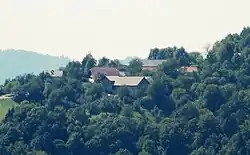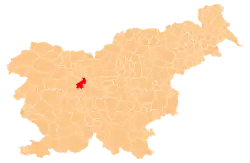Belo, Medvode
Belo (pronounced [ˈbeːlɔ]) is a small settlement in the Municipality of Medvode in the Upper Carniola region of Slovenia.[2] In the past it was known as Nawelim in German.[3]
Belo | |
|---|---|
 Belo | |
 Belo Location in Slovenia | |
| Coordinates: 46°4′44.13″N 14°21′36.94″E | |
| Country | |
| Traditional region | Upper Carniola |
| Statistical region | Central Slovenia |
| Municipality | Medvode |
| Area | |
| • Total | 1.18 km2 (0.46 sq mi) |
| Elevation | 639.6 m (2,098.4 ft) |
| Population (2002) | |
| • Total | 27 |
| [1] | |
Name
Belo was attested in historical documents as Weizzenperg in 1364, and as Wela, Nabela, and Vnnderwela in 1498, among other spellings.[4]
Cultural heritage
Several structures in Belo are registered as cultural heritage:
- The farm at Belo no. 1, known as the Lenart farm (Slovene: pr' Lenart), consists of a single-story stone house with a 16th-century foundation; the year 1858 is carved into the door casing. There is a cottage bearing the year 1827; this was a building used by a retired farmer that continued to live on the farm. Other structures include a granary with a cellar, a stone barn with a mow, a beehouse, a fruit-drying shed, and a hayrack.[5] There is also a plaque on the house commemorating the communist people's hero Lizika Jančar (a.k.a. Majda; 1919–1943), who was shot in Belo on 20 March 1943.[5][6]
- The house at Belo no. 2 stands on the eastern edge of the settlement, east of the farm at Belo no. 1. It is a two-story stone house from the end of the 20th century completely reconstructed from older architectural elements brought from elsewhere, including a door casing from green tuff, window casings, and beamed ceilings.[7]
 Plaque commemorating Lizika Jančar (1919–1943)
Plaque commemorating Lizika Jančar (1919–1943)
References
- Statistical Office of the Republic of Slovenia
- Medvode municipal site
- "Uebersicht der in Folge a. h. Entschließung vom 26. Juli 1849 genehmigten provisorischen Gerichtseintheilung des Kronlandes Krain". Intelligenzblatt zur Laibacher Zeitung. No. 141. November 24, 1849. p. 13.
- "Belo". Slovenska historična topografija. ZRC SAZU Zgodovinski inštitut Milka Kosa. Retrieved February 8, 2021.
- Slovenian Ministry of Culture register of national heritage Archived April 7, 2015, at the Wayback Machine reference number ešd 9999
- Jakopič, Albert, & Franc Benedik. 1978. Vodnik po partizanskih poteh. Ljubljana: Borec, p. 60.
- Slovenian Ministry of Culture register of national heritage Archived April 7, 2015, at the Wayback Machine reference number ešd 16290
This article is issued from Wikipedia. The text is licensed under Creative Commons - Attribution - Sharealike. Additional terms may apply for the media files.
